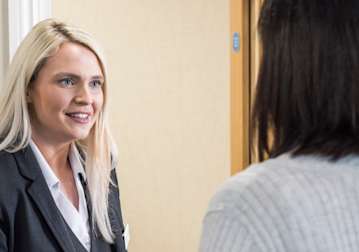Embalming is essentially preserving the body using chemicals to slow down the process of deterioration. It’s often recommended if families want to visit their loved one in a chapel of rest, or when the funeral isn’t going to take place straight away. Embalming can also help your loved one look more at peace, especially if they died after an accident or illness.
If you’ve ever wondered ‘What do embalmers do?’ or considered a career as an embalmer, we can help. Here, Rachel Carline, 31, an embalmer with Co-op Funeralcare in Oldham tells us all about her job – and find out how you can join the profession.
‘My husband dreads going out with people we don’t know. As soon as they ask me “What do you do?”, he knows the whole evening will be taken up with talking about my job! But I don’t mind answering their questions. There’s nowhere else really people can go to can ask them, or they worry that bringing up these topics with friends will make them look weird. That’s one of the reasons I started my podcast, The Eternal Debate, to help answer all those questions.
‘I started training to be an embalmer when I was quite young, at 22. I always knew I wanted to work in funerals. I was fascinated with Ancient Egypt as a child, especially the mummies, and I loved learning about human biology. When my grandma died, I went to see her but she didn’t look good. That experience must have left a lasting impression, as years later I decided I wanted to become an embalmer. I wanted to care for people after they died, to do the very last thing you could for that person.
‘I started as a funeral arranger in a Co-op funeral home, but I began going in early to learn from the embalmers. That gave me vital work experience and helped me work out if being an embalmer was what I really wanted. Many people think it’s just doing hair and make-up, or preserving the body, but it’s so much more. Seeing everything that was involved convinced me it was the right role for me. I have the utmost respect for everyone I embalm, and I believe my job is a real privilege.
‘My training involved 5 theoretical and 2 practical exams (see box below for more information). There’s so much to learn – embalming is a mixture of maths, chemistry and anatomy. To work out the amounts of fluids you need, such as formaldehyde, water and dyes, you have to know how much the body weighs, how long it's been since the person died, how long until the funeral, plus many other factors. But we always see them as a whole person, not an equation.




